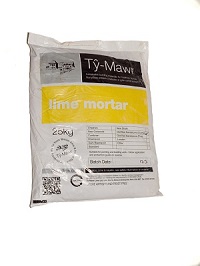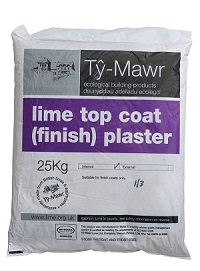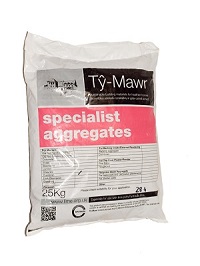Lime
Lime has been used as the binder in mortars, plasters, renders and paints for thousands of years. The oldest sample of lime plaster that we are aware of is in the Weizmann Institute in Israel and dates back to 12, 000 BC.
Portland cement was patented in 1824 and in the early to mid-1900s became widely available. It became cheaper than lime as well as being faster setting, easier to use and stronger, so from the mid-1900s it began to dominate the construction industry and has done so ever since, resulting in the near extinction of the building lime industry.
It is only in the last twenty years or so that the damage caused by ‘modern’, hard, impervious materials have been fully understood and documented. There is now a widespread realisation that it is vitally important to use lime in the conservation and repair of old and historic buildings. As a result, there has been a huge revival in its use.
Another factor that has driven the resurgence in the use of lime is that it is widely regarded as being less damaging environmentally than its modern counterparts. It is therefore also being specified and used in new ecological builds.
There are now many types of building limes on the market. It is crucially important to understand their differences and the way in which they perform, only then is it possible to make an informed choice about which lime to use for different applications, environments and times of the year.
Slaked/High Calcium/Putty/Air/‘Fat’ or Non-Hydraulic Lime
This lime is produced by slaking fresh Quicklime in an excess of water. It is also known as non-hydraulic lime because it requires exposure to air in order to carbonate and does not set underwater. This lime is often regarded as the most appropriate lime for old buildings where maximum permeability and flexibility is required.
Our premixed ‘wet’ products are made from this lime putty with the addition of aggregates and/or fibre, using the hot mix method, they can be in the form of mortars, plasters or limewash.
Hydrated or ‘Bag’ Lime
This is the lime generally available in builder’s merchants. It is a non-hydraulic lime produced by slaking Quicklime with a shortfall of water which results in a powder. It is generally considered to be an inferior product to the fat lime putty described above for a number of reasons but primarily because it starts to degrade from the moment it is made and can actually fully carbonate in the bag before use. Widespread use of ‘bag’ lime has given ‘lime’ a poor name because of the instances where it simply has none of its original properties left by the time the end-user works with it, hence it fails, dusts etc. If ‘bag’ lime is the only option, then it should be purchased as fresh as possible and left to soak for two days in clean water. Although the resulting product is chemically the same as ‘fat’ lime putty, it is physically different, in particular, it is less ‘sticky’.
This s a ‘hydrated’ lime is supplied as a powder, and produced from limestone containing clay and other impurities which enable it to set without exposure to air; it is therefore used for providing a faster initial set in more extreme conditions including under water. There are many types of hydraulic lime, they are categorised as NHL = Natural Hydraulic Lime followed by a number which relates to the compressive strength of the lime.
These limes have become increasingly popular over the last decade because of their comparative ‘ease of use’ and increased setting strength, compared to ‘fat lime’, but they do have reduced breathability and flexibility – please see graph above.
Choosing a Lime
It is important for the well-being of the building that the most appropriate lime product is chosen. Every situation needs to be carefully assessed e.g. in terms of:
- The softness of the stone, brick etc – this should be a major factor in selection. The mortar should always be ‘softer’ than the stone/brick, see table below.
- The environmental conditions – where the environment is very wet e.g. sea-defence walls, canal walls, cellars, copings, pavings, a hydraulic lime is more appropriate because of its ability to set under water, see table below.
- The existing materials – repairing like-with-like – this will usually provide the most satisfactory solution both aesthetically and technically, however it should not be done without considering the performance of the original materials.
- The time of year – the ideal time to do fat lime work, particularly external work, is during the spring and early summer, lime work should never be done when the temperature is likely to fall below 5°C before carbonation has taken place, which is the same for cement. Therefore, if work cannot be rescheduled to another time of the year consideration should be given to adding a pozzolan to a fat lime (e.g. brickdust, calcined clay) to speed up the set or to using a hydraulic lime. Appropriate protection is vital.
- the available time – occasionally work is programmed without enough time to support the use of the materials specified, rapid builds necessitate rapid sets, therefore, adding a pozzolan to a fat lime or using a hydraulic lime should be considered (if work can’t be reprogrammed!).
Occasionally, the choice still seems to be based on the availability of skills (or lack of them) and this does mean that often in these cases that the stronger hydraulic limes or even cement are introduced into buildings where they have no place and will, in the long term, almost certainly contribute to damp problems and damage the very fabric of the building.
If you have any questions please do not hesitate to contact our technical team on 01874 611 350 or tymawr@lime.org.uk
Appointing a Contractor
We strongly recommend that you use a contractor experienced in the ‘type’ of lime that has been specified for your building as they require differing skills.
We would also advise that you attend an Introduction to Lime course regularly held at Ty-Mawr to give you an understanding of the needs of old buildings and choosing and using appropriate lime products.
Extra Resources
We have developed a selection table and calculator to assist with product selection and data sheets and application guides are all available on this website as well as ‘how-to’ videos. We have also developed a Knowledge Hub to help with any questions you may have, a checklist to remind you of all that needs doing along the way in preparing for, applying and using lime and a Troubleshooting guide to assist you if you experience any difficulties or you can of course still ring us on 01874 611350 if you are still unsure about anything!
Alternatively, click here to take a look at our Lime In Building Brochure.
 |
 |
 |
 |
| Hydraulic Limes | Lime Mortars | Lime Plaster | Aggregates |
